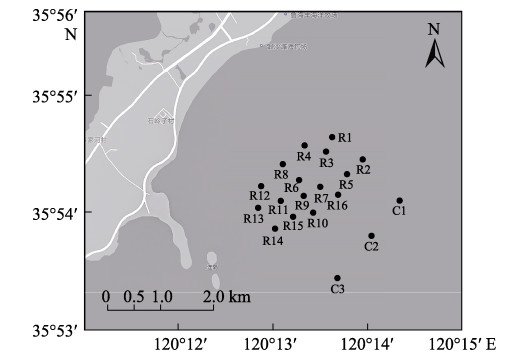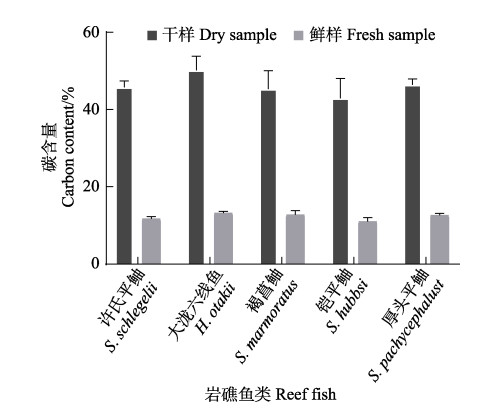2. 中国水产科学研究院黄海水产研究所农业农村部海洋渔业与可持续发展重点实验室 碳汇渔业实验室 山东 青岛 266071;
3. 青岛市黄岛区薛家岛农业服务中心 山东 青岛 266530
2. Yellow Sea Fisheries Research Institute, Chinese Academy of Fishery Sciences, Key Laboratory of Marine Fisheries and Sustainable Development, Ministry of Agriculture and Rural Affairs, Carbon-Sink Fisheries Laboratory, Qingdao 266071, China;
3. Agricultural Service Center of Xuejiadao, Qingdao 266530, China
目前,全球仍处于气候变暖的大趋势中,严重影响地球生态系统的健康发展(Cameron et al, 2013)。减缓全球变暖的措施有2种,一种是减排,减少温室气体排放,另一种是增汇(负减排),吸收并储存大气中的CO2。增汇这一措施既能减缓气候变化,还可以通过碳贸易推动国家和社会的发展(焦念志, 2018)。海洋作为地球上最大的碳库,具有巨大的碳汇功能,能吸收人类排放CO2总量的20%~35%,约储存全球CO2总量的93%,每年约有90 pg的CO2通过海洋循环(Khatiwala et al, 2009; 唐启升等, 2016),有效地延缓温室气体排放对全球气候的影响。渔业碳汇是海洋碳汇的重要组成部分,是指通过渔业生产活动促进水生生物吸收水体中的CO2,并通过收获把这些已经转化为生物产品的碳移出水体或通过生物沉积作用将其沉降于水体的过程和机制,大大提高了水域生态系统吸收大气CO2的能力(唐启升等, 2022),上述渔业生产活动被称为碳汇渔业。海洋牧场是碳汇渔业的一种典型模式(唐启升等, 2016),通过人工鱼礁投放、藻场修复为水生生物提供生长、繁殖等栖息场所,牧场海域滋生的附着生物、浮游生物、底栖生物是鱼、虾、蟹、海参(Apositichopus japonicus)等渔业资源的天然饵料,牧场内无需进行人为投饵,其对生态环境的改善作用可显著提升海域初级生产力,资源养护效应促使生物多样性增加,加速碳在食物网各营养级间的转化和传输。目前,对海洋牧场碳汇的研究主要集中在藻类、贝类、海参等海珍品等海洋生物方面(郭文杰, 2016; 公丕海等, 2014; 公丕海, 2014),在人工鱼礁固碳材料的开发等方面也有少量研究(李娇等, 2016)。人工鱼礁对岩礁鱼类具有显著的增殖效果,人工渔场的营造是海洋牧场建设目的之一,而与海洋牧场其他碳汇因子相比,岩礁鱼类碳汇作用的研究较少,这主要是因为鱼类呼吸过程将光合作用固定的碳返回到大气中,被认为是减弱了海洋碳汇的效率,使人们主要关注其作为碳源对生态系统的影响(徐皓等, 2011),但越来越多的研究表明,鱼类等海洋动物在海洋碳循环和储存上有显著贡献(Wilson et al, 2009; Czamanski et al, 2012)。鱼类通过自身的生理活动、自然沉积和被捕捞的方式影响着海洋碳汇过程。海洋硬骨鱼类肠道分泌的HCO3–可与肠道吸收的的Ca2+、Mg2+发生反应,形成碳酸盐(吕为群等, 2012)。Wilson等(2009)估算巴哈马群岛海洋硬骨鱼类每年产生碳酸盐大约6×103 t,沉积后进入海洋碳循环。
灰色−马尔科夫模型是一个将灰色GM(1, 1)预测模型和马尔科夫模型进行组合的模型,它以GM(1, 1)模型为建模基础,使用马尔科夫模型对GM(1, 1)模型的预测误差进行修正,提升建模对象的预测精度,达到较好预测效果,近年来,被广泛应用于环境科学、数学工程、金融投资等多个学科领域(Li et al, 2007; Govindan et al, 2021; Yin et al, 2018)。灰色−马尔科夫模型对数据量少、波动幅度大的随机过程具有较好的预测效果(Deng, 1997)。马创等(2020)和Jia等(2020)运用此模型对波动性和随机性较强的粮食产量和煤炭消费量进行预测,取得较好的预测结果。海洋牧场在我国发展的时间较短,大部分海洋牧场缺乏连续长期的资源调查,且岩礁鱼类物种和种群结构受多种复杂因素影响,具有较高的不稳定性。基于灰色−马尔科夫模型的优越性,本研究运用此模型首次对水生生物碳储量进行研究,由于模型对原始时间序列要求呈规律性,基于已有渔业资源调查数据,本研究选取2017春季、2018年冬季、2019年春季和2020年冬季的调查结果,对岩礁鱼类碳储量进行预测,以期为评估岩礁鱼类碳汇潜力、建立渔业碳汇基础上的海洋牧场岩礁鱼类资源开发策略提供依据。
1 材料与方法 1.1 数据来源本研究岩礁鱼类资源量数据来自石雀滩海域海洋牧场(35°53′20″~35°55′0″N, 120°12′40″~120°14′20″E) 2017—2020年地笼网渔业资源调查。调查海域分为鱼礁区(R区)和对照区(C区),采用大面调查法,分别布设16个站位和3个站位(图 1)。对照区选取在离鱼礁区平行距离1 200 m外(章守宇等, 2006; 李娇等, 2018)。2个区域调查水深平均为18和27 m。礁区面积为22.13×104 m2,平均礁高为2 m。调查时间为2017年4月(春季)、2018年1月(冬季)、2019年5月(春季)和2020年12月(冬季),4次调查时间均选在调查月下旬,作业时间均为24 h。鱼礁区4个调查航次底层水体平均水温为8.84 ℃、5.38 ℃、10.62 ℃和4.79 ℃,对照区的平均水温分别为8.97 ℃、5.84 ℃、10.60 ℃和5.17 ℃。调查网具单个地笼网规格:长为8 m、宽为0.22 m、高为0.22 m。岩礁鱼类碳含量数据来自1.2样品处理。

|
图 1 石雀滩海洋牧场采样站位 Fig.1 Sampling sites in the Shique Beach marine ranching R:鱼礁区;C:对照区 R: Reef area; C: Contrast area |
由于渔业资源调查中岩礁鱼类的资源量数据为鲜样状态,因此,需要计量岩礁鱼类鲜样碳含量。卢振彬等(2004)把采集物种作为一个整体检测其鲜样碳含量。崔晨(2020)根据物种干样碳含量和含水量计算其鲜样碳含量。借鉴相关人员的研究方法,本研究对采样样品进行如下处理:首先将调查取样采集到的许氏平鲉(Sebastes schlegelii)、大泷六线鱼(Hexagrammos otakii)、褐菖鲉(Sebasticus marmoratus)、铠平鲉(Sebastes hubbsi)和厚头平鲉(Sebastes pachycephalus)去掉表面污物及其他附着物后测定湿质量(每组选取规格相近的3尾鱼进行实验,共15尾);其次于70 ℃烘干至恒重后测定干质量,将烘干后的样品粉碎至100目,称取(1.68±0.18) mg,使用Vario EL cube元素分析仪,测定不同种类干样碳含量(%);最后使公式:鲜样碳含量=(1–含水量)×干样碳含量(崔晨, 2020),计算不同种类鲜样碳含量(%)。
1.3 碳储量估算方法Wilson等(2009)根据巴哈马群岛鱼类生物量、碳酸盐排泄率和群岛面积对其碳酸盐产量进行估算;李娇等(2013)提出了人工鱼礁区主要碳汇因子的碳计量公式;杨茜等(2013)研究表明,渔业碳库的发展模式可借鉴林业碳库和IPCC的基本方法。通过借鉴以上研究结果并结合本研究的具体情况,估算石雀滩海洋牧场鱼礁区、对照区海域岩礁鱼类碳储量公式为:
| $ P_{i }=B_{i}/(L×m) $ | (1) |
| $ C = \sum\limits_{i = 1}^n {{P_i}} \times V \times {R_i} $ | (2) |
式中,Pi为对应海域i种岩礁鱼类现存生物量平均资源密度(t/m3);Bi为对应海域布设站位采捕岩礁鱼类总资源量(t);L为单个地笼网体积(m3);C为对应海域岩礁鱼类总碳储量(t);V为对应海域体积(m3);Ri为i种类岩礁鱼类鲜样碳含量;m为对应海域布设站位有效个数;n为对应海域采集岩礁鱼类种类个数。
1.4 碳储量预测模型 1.4.1 构建模型灰色−马尔科夫模型以GM(1, 1)模型为建模基础,采用马尔科夫模型对GM(1, 1)模型的预测误差进行修正。因而,建立GM(1, 1)模型是构建岩礁鱼类碳储量灰色−马尔科夫模型的第一步,可参考岳冬冬等(2012)的构建方法。检验GM(1, 1)模型,如果模型无法通过检验,运用马尔科夫模型修正GM(1, 1)模型的预测误差。修正步骤如下:
将实测碳储量值与GM(1, 1)模型拟合碳储量值的商划分为m种状态区间,公式为:
| $ E_{m }=[K_{m}, L_{m}] $ | (3) |
式中,Em为第m种状态,Km、Lm为第m种状态的上、下界。区间上、下界的计算参考Zouhair等(2021)的方法。划分状态区间的数目根据实际情况而来,应与原始序列的数量呈正比,一般为3~5个(Guan et al, 2018)。
根据状态转移概率构造状态转移概率矩阵,状态转移概率公式为:
| $ P_{ij} = M_{ij} / M_{i } $ | (4) |
式中,Mij表示状态Ei转变为状态Ej的总次数;Mi表示状态Ei在样本中出现的总次数。当Mi处于样本序列末尾时,不计入算式中(马创等, 2020)。状态转移概率矩阵用P表示(Jia et al, 2020)。
根据上一年度岩礁鱼类碳储量值所处状态的状态向量和P,得到下一年岩礁鱼类碳储量值的状态向量:
| $ X_{(k)}=X_{(k–1)}×P $ | (5) |
式中,X(k)为k时刻的状态向量;X(k–1)为k–1时刻所处状态的状态向量;P为状态转移概率矩阵。以k时刻状态向量中最大概率所处的状态作为k时刻可能发展的状态。
根据k时刻岩礁鱼类碳储量值所处的状态区间和对应时刻GM(1, 1)模型的拟合值,计算经过马尔科夫模型修正后的拟合值:
| $ {\hat Z^{(0)}}(K) = {\hat X^{(0)}}(K) \times [({K_i} + {L_i})/2] $ | (6) |
式中,
本研究采用残差检验和后验差检验2种方法对GM(1, 1)模型和灰色−马尔科夫模型的拟合值进行检验,计算方法参考Jia等(2020)。模型精度等级划分标准见表 1。如有1项不合格,则需要对模型进一步改进。
|
|
表 1 精度检验等级参照表 Tab.1 Refer to the accuracy test grade |
4次调查航次出现的岩礁鱼类有许氏平鲉、大泷六线鱼、褐菖鲉、铠平鲉和厚头平鲉,其干样碳含量分别为(45.73±1.37)%、(50.19±2.93)%、(45.34± 3.87)%、(42.95±4.18)%和(46.37±1.27)%;鲜样碳含量分别为(11.76±0.42)%、(13.25±0.34)%、(12.78±0.89)%、(11.05± 0.81)%和(12.67±0.36)%。从图 2可以看出,5种岩礁鱼类鲜样与干样的碳含量变化趋势基本一致。4次监测中,鱼礁区和对照区岩礁鱼类资源量及碳储量统计结果见表 2。从表 2可以看出,鱼礁区碳储量呈波动式下降趋势,对照区呈先上升后下降趋势,鱼礁区整体大于对照区。根据瑞典碳税率150美元/(t·C)的计算方法,鱼礁区岩礁鱼类可创造0.73×104~4.40×104美元的碳收益。

|
图 2 岩礁鱼类干样碳含量和鲜样碳含量平均值 Fig.2 Mean carbon content of dry and fresh samples of reef fish |
|
|
表 2 鱼礁区和对照区岩礁鱼类资源量及碳储量 Tab.2 Biomass and carbon storage of reef fish in reef area and contrast area |
GM(1, 1)模型拟合值ε为0.2,C为0.12,ρ为1(表 3)。从表 1可以看出,模型检验不合格。修正步骤见表 4和表 5,修正结果见表 6。灰色−马尔科夫模型拟合值的ε为0.08,C为0.04,ρ为1,达到模型检验要求,且拟合精度有所提升。对比可以看出(图 3),灰色−马尔科夫模型拟合碳储量趋势与实测碳储量变化趋势一致,模型拟合值与实测值十分接近,因此,灰色−马尔科夫模型预测效果更为准确。
|
|
表 3 GM(1, 1)模型拟合鱼礁区岩礁鱼类碳储量 Tab.3 Fitted values of GM (1, 1) model for carbon storage of reef fish in reef area |
|
|
表 4 鱼礁区岩礁鱼类碳储量状态划分区间 Tab.4 The state division interval of carbon storage of reef fish in reef area |
|
|
表 5 鱼礁区岩礁鱼类碳储量所处状态 Tab.5 The state of carbon storage of reef fish in reef area |
|
|
表 6 灰色−马尔科夫模型拟合鱼礁区岩礁鱼类碳储量情况 Tab.6 Fitted values of Grey−Markov model for carbon storage of reef fish in reef area |

|
图 3 鱼礁区岩礁鱼类碳储量实测值与拟合值对比 Fig.3 Comparison of actual and fitted values of carbon storage of reef fish in reef area |
从表 6可以看出,计算1步、2步、3步、4步状态转移概率矩阵P,根据公式(3)、(4)计算2021年春季、2022年冬季、2023年春季和2024年冬季鱼礁区岩礁鱼类碳储量预测值(表 7)。由预估结果可知,石雀滩海洋牧场鱼礁区岩礁鱼类碳储量呈下降趋势。
| $ \begin{array}{*{20}{c}} {P = \left({\begin{array}{*{20}{l}} 0&0&1 \\ 1&0&0 \\ 1&0&0 \end{array}} \right), \;\;{P^2} = \left({\begin{array}{*{20}{l}} 1&0&0 \\ 0&0&1 \\ 0&0&1 \end{array}} \right), } \\ {{P^3} = \left({\begin{array}{*{20}{l}} 0&0&1 \\ 1&0&0 \\ 1&0&0 \end{array}} \right), \;{P^4} = \left({\begin{array}{*{20}{l}} 1&0&0 \\ 0&0&1 \\ 0&0&1 \end{array}} \right)} \end{array} $ |
|
|
表 7 鱼礁区岩礁鱼类碳储量预测值 Tab.7 Predicted values of carbon storage of reef fish in reef area |
碳元素的计量是评估生物碳汇能力的重要组成部分(Hassett et al, 1997),分析比较岩礁鱼类与其他生物的碳含量特征,有利于表明岩礁鱼类在海洋碳汇过程中的作用。本研究表明,岩礁鱼类干样碳含量分布范围为42.95%~50.19%,平均值为(46.11±2.34)%。郭文杰(2016)测定大型海藻干样碳含量分布范围为27.60%~39.80%,平均值为(35.71±1.90)%。公丕海等(2014)计量附着牡蛎贝壳和软体的干样碳含量平均值分别为(11.60±0.03)%和(38.70±0.68)%。周丽等(2014)以南亚热带中幼龄针阔混交林为研究对象,测定树根、树杆、树枝和树叶干样碳含量平均值分别为45.07%、46.73%、46.30%和47.72%。与本研究相比,岩礁鱼类干样碳含量整体大于大型藻类和附着贝类,稍低于红树林。马欢等(2017)计量海洋生物鲜样碳含量分布范围为4.02%~11.36%。本研究计量岩礁鱼类鲜样碳含量分布范围为11.05%~13.25%,平均值为12.30%,比马欢等(2017)研究结果略高,这主要因为二者研究样品处理方法不同,海洋生物不同组织器官含水量与碳含量差异较大。马欢等(2017)将海洋生物分为骨骼、肌肉、内脏等不同组织器官,本研究将岩礁鱼类作为一个整体。卢振彬等(2004)采用化学分析法分析底层鱼类鲜样碳含量分布范围为8.10%~ 29.55%,平均值为13.54%,比本研究略高,这主要因为研究底层鱼类物种范围大于本研究,此外,二者不同的碳含量分析方法也影响了最终结果。
3.2 GM(1, 1)模型和灰色−马尔科夫模型的应用邓聚龙(2002)于1982年提出灰色系统理论,该理论是一种处理贫信息、不确定性系统的理论。GM(1, 1)模型作为灰色系统理论的核心,对少量的、不明确的信息有着原理简单、计算量小的特点(Deng, 1997),这对于缺乏长期、连续数据的渔业研究来说,有很大的应用与发展前景(陈新军, 2003)。岳冬冬等(2012)运用GM(1, 1)模型对我国水产品(海水产品、淡水产品、养殖和捕捞)的产量进行预测,除了捕捞产量模型预测效果为Ⅲ级外,其余的预测效果都为Ⅰ级。在本研究中,GM(1, 1)模型对岩礁鱼类碳储量模型检验效果为Ⅳ级,即模型检验不合格,原因是海洋牧场岩礁鱼类碳储量受多种复杂因素的影响,具有较强的波动性和随机性,而GM(1, 1)模型是一种以指数型曲线拟合原始数据的预测方法,所以,当原始时间序列数据趋势波动起伏较大、呈现非平稳的随机性时,GM(1, 1)模型预测结果图像则会呈现一条整体平滑的曲线(图 3),这时该模型预测精度偏低(王建华等, 2020)。以马尔科夫过程为理论基础的马尔科夫模型具有无后效性和遍历性,该模型是根据系统现在的状态及其变化趋势,预测其在未来某一特定时间可能出现的状态,很好地弥补了GM(1, 1)模型在反映时间序列波动性方面的不足(Deng, 1997)。灰色−马尔科夫模型综合了GM(1, 1)模型和马尔科夫模型的优势,考虑到原始序列数据数量和岩礁鱼类历史碳储量对未来碳储量的影响,极大地提高了模型预测的准确性,预测精度提升12%,充分说明了灰色−马尔科夫模型的优越性,能实现岩礁鱼类碳储量短期的准确预测。
3.3 岩礁鱼类的碳汇能力与潜力岩礁鱼类是海洋牧场养护和增殖的目标种群,是人工鱼礁生态系统最具典型的生物群落,具有巨大的生态和经济效益,岩礁鱼类对碳在海洋中的循环、沉降和移出等过程具有重要影响,是渔业碳汇中关键碳汇因子之一,但从目前来看,对岩礁鱼类碳汇能力的研究较少。本研究对山东青岛石雀滩海域海洋牧场岩礁鱼类的生物碳储量进行了统计和预测。研究表明,鱼礁区岩礁鱼类碳储量呈波动式发展,主要是岩礁鱼类资源量季节差异引起的(吴忠鑫等, 2012; Aburto-Oropeze et al, 2001)。刘瑞玉(1992)研究表明,鱼类的种类组成、数量分布和环境温度有明显的季节变化。本研究中,2017年和2019年为春季资源调查结果,平均水温为8.84 ℃和10.62 ℃,2018和2020年为冬季资源调查结果,平均水温为5.38 ℃和4.79 ℃,春季水温回暖,资源量随水温的升高而增加。对照区2020年冬季地笼未采捕到岩礁鱼类,基于地笼渔获量得到的岩礁鱼类碳储量为0,这主要因为在对照区和鱼礁区水温都较低的环境下,人工鱼礁为岩礁鱼类提供的触碰基质、饵料供应和其他条件在水温较低的冬季更能满足岩礁鱼类的需求,对岩礁鱼类资源具有较好的聚集效果(李娇等, 2020; Mills et al, 2017)。本研究基于地笼网采捕数据统计岩礁鱼类碳储量,而地笼网相对其他网具存在捕获种类与网获量相对较少的特点(Olin et al, 2004),且本研究只研究了岩礁鱼类现存生物量的碳汇能力,没有考虑被捕捞和死亡沉积岩礁鱼类生物量,因而,本研究估算的岩礁鱼类碳储量小于实际碳储量。预测固碳能力对制定开发策略至关重要(Jiang et al, 2018)。权伟等(2014)基于时间序列模型ARIMA对浙江温州洞头大型藻类碳汇强度进行预测分析,建议大力发展以海水养殖为主体的碳汇渔业,开展海洋生物碳汇功能与碳汇渔业潜力的基础科学研究。本研究预测,石雀滩海洋牧场岩礁鱼类碳储量呈下降趋势,这可能与岩礁鱼类被过度捕捞有关,岩礁鱼类作为重要经济鱼类,是传统渔业的主要捕捞对象。海洋牧场经营者可加强人工鱼礁建设的投入力度,扩大投礁海域面积,增殖放流岩礁鱼类,提升岩礁鱼类资源量,增大岩礁鱼类碳储量。
ABURTO-OROPEZA O, BALART E F. Community structure of reef fish in several habitats of a rocky reef in the Gulf of California. Marine Ecology, 2001, 22(4): 283-305 |
CAMERON R E, HENNIGAR C R, MACLEAN D A, et al. A comprehensive greenhouse gas balance for a forest company operating in Northeast North America. Journal of Forestry, 2013, 111(3): 194-205 DOI:10.5849/jof.12-043 |
CHEN X J. Grey system theory in fisheries science. Beijing: China Agriculture Press, 2003: 1-32 [陈新军. 灰色系统理论在渔业科学中的应用. 北京: 中国农业出版社, 2003: 1-32]
|
CUI C. Preliminary study on carbon sink function of artificial reef area in Xiangyun Bay marine ranching. Masterxs Thesis of Hebei Agricultural University, 2020 [崔晨. 祥云湾海洋牧场人工鱼礁区碳汇功能初步研究. 河北农业大学硕士研究生学位论文, 2020]
|
CZAMANSKI M, NUGRAHA A, PONDAVEN P, et al. Carbon, nitrogen and phosphorus elemental stoichiometry in aquacultured and wild-caught fish and consequences for pelagic nutrient dynamics. Marine Biology, 2012, 158(12): 2847-2862 |
DENG J L. The foundation of grey system theory. Journal of Grey System, 1997, 9(1): 40-48 |
DENG J L. Grey theory. Wuhan: Huazhong University of Science & Technology Press, 2002 [邓聚龙. 灰理论基础. 武汉: 华中科技大学出版, 2002]
|
GONG P H, LI J, GUAN C T, et al. Estimation and experiment of carbon sequestration by oysters attached to the enhancement artificial reefs in Laizhou Bay, Shandong, China. Chinese Journal of Applied Ecology, 2014, 25(10): 3032-3038 [公丕海, 李娇, 关长涛, 等. 莱州湾增殖礁附着牡蛎的固碳量试验与估算. 应用生态学报, 2014, 25(10): 3032-3038] |
GONG P H. The effect of carbon fixation and carbon sequestration estimate of seafood in marine ranching. Masterxs Thesis of Shanghai Ocean University, 2014 [公丕海. 海洋牧场中海珍品的固碳作用及固碳量估算. 上海海洋大学硕士研究生学位论文, 2014]
|
GOVINDAN K, RAMALINGAM S, BROUMI S, et al. Traffic volume prediction using intuitionistic fuzzy Grey-Markov model. Neural Computing and Application, 2021, 33(19): 12905-12920 DOI:10.1007/s00521-021-05940-9 |
GUAN J, FENG Y, YING M S, et al. Markov chains and its applications. Journal of Comput and System Sciences, 2018, 95: 55-68 DOI:10.1016/j.jcss.2018.01.005 |
GUO W J. The basic study on algae carbon sinks in the artificial reef areas around the Zhangzi Island. Masterxs Thesis of Dalian Ocean University, 2016 [郭文杰. 獐子岛人工鱼礁区藻场碳汇基础研究. 大连海洋大学硕士研究生学位论文, 2016]
|
HASSETT R P, CARDINALE B, STABLER L B, et al. Ecological stoichiometry of N and P in pelagic ecosystems: Comparison of lakes and oceans with emphasis on the zooplankton-phytoplankton interaction. Limnology and Oceanography, 1997, 42: 648-662 DOI:10.4319/lo.1997.42.4.0648 |
JIA Z Q, ZHOU Z F, ZHANG H Z, et al. Forecast of coal consumption in Gansu Province based on Grey-Markov chain model. Energy, 2020, 199: 117444 DOI:10.1016/j.energy.2020.117444 |
JIANG J, HUANG Y Y, MA S, et al. Forecasting responses of a northern peatland carbon cycle to elevated CO2 and a gradient of experimental warming. Journal of Geophysical Research-Biogeosciences, 2018, 123(3): 1057-1071 DOI:10.1002/2017JG004040 |
JIAO N Z. Blue carbon action in China. Beijing: Science Press, 2018: 3-6 [焦念志. 蓝碳行动在中国. 北京: 科学出版社, 2018: 3-6]
|
KHATIWALA S, PRIMEAU F, HALLT, et al. Reconstruction of the history of anthropogenic CO2 concentration in the ocean. Nature, 2009, 462(7271): 346-349 DOI:10.1038/nature08526 |
LI J, GONG P H, CHANG Q, et al. Research on progress behavioral ecology of reef fish. Progress in Fishery Sciences, 2020, 41(6): 192-199 [李娇, 公丕海, 常青, 等. 岩礁鱼类行为生态学研究进展. 渔业科学进展, 2020, 41(6): 192-199] |
LI J, GONG P H, CHANG Q, et al. Carbon sequestration of additives of artificial reefs and its effect on carbon fixation of Ostrea plicatula gemelin. Progress in Fishery Sciences, 2016, 37(6): 100-104 [李娇, 公丕海, 常青, 等. 人工鱼礁材料添加物碳封存能力及其对褶牡蛎(Ostrea plicatula)固碳量的影响. 渔业科学进展, 2016, 37(6): 100-104] |
LI J, GUAN C T, CUI Y, et al. Preliminary analysis of sink mechanism and potential of artificial reef ecosystem. Progress in Fishery Sciences, 2013, 34(1): 65-69 [李娇, 关长涛, 崔勇, 等. 人工鱼礁生态系统碳汇机理及潜能分析. 渔业科学进展, 2013, 34(1): 65-69] |
LI J, ZHANG Y, YUAN W, et al. Research on artificial reef ecosystem health assessment based on fuzzy synthetic evaluation. Progress in Fishery Sciences, 2018, 39(5): 10-19 [李娇, 张艳, 袁伟, 等. 基于模糊综合评价法的人工鱼礁生态系统健康研究. 渔业科学进展, 2018, 39(5): 10-19] |
LI X, WANG X Y, SHAO W, et al. Forecast of flood in Chaohu lake basin of China based on Grey-Markov theory. Chinese Geographical Science, 2007, 17(1): 64-68 DOI:10.1007/s11769-007-0064-3 |
LIU R Y. Ecology and living resources of Jiaozhou Bay. Beijing: Science Press, 1992: 352-379 [刘瑞玉. 胶州湾生态学和生物资源. 北京: 科学出版社, 1992: 352-379]
|
LU Z B, HUANG M Z. Studies on frophic level and organic carbon contents of main economic nekton in Fujian coastal waters. Journal of Oceanography in Taiwan Strait, 2004, 23(2): 153-158 [卢振彬, 黄美珍. 福建近海主要经济渔业生物营养级和有机碳含碳研究. 台湾海峡, 2004, 23(2): 153-158] |
LV W Q, CHEN A Q, LIU H, et al. Carbonate deposits in marine fish intestines: Contribution of marine fish cultures to carbon sink fisheries. Journal of Fisheries of China, 2012, 36(12): 1924-1932 [吕为群, 陈阿琴, 刘慧, 等. 鱼类肠道的碳酸盐结晶物: 海水鱼类养殖在碳汇渔业中的地位和作用. 水产学报, 2012, 36(12): 1924-1932] |
MA C, YUAN Y, YOU H S, et al. Agricultural product output forecasting method based on Grey-Markov model. Computer Science, 2020, 47(S1): 535-539 [马创, 袁野, 尤海生, 等. 基于灰色-马尔可夫模型的农产品产量预测方法. 计算机科学, 2020, 47(S1): 535-539] |
MA H, QIN C X, CHEN P M, et al. Study of biomass carbon storage in Zhelin Bay marine ranch of South China Sea. South China Fisheries Science, 2017, 13(6): 56-64 [马欢, 秦传新, 陈丕茂, 等. 南海拓林湾海洋牧场生物碳储量研究. 南方水产科学, 2017, 13(6): 56-64] |
MILLS K A, HAMER P A, QUINN G P, et al. Artificial reefs create distinct fish assemblages. Marine Ecology Progress Series, 2017, 585: 155-173 DOI:10.3354/meps12390 |
OLIN M, KURKILAHTI M, PEITOLA P, et al. The effects of fish accumulation on the catchability of multimesh gillnet. Fisheries Research, 2004, 68(1/2/3): 135-147 |
QUAN W, YING M M, KANG H J, et al. Carbon sink capacity forecast of macroscopic algae in the coastal areas of Dongtou county based on timed series model. Chinese Agriculture Science Bulletin, 2014, 30(8): 63-67 [权伟, 应苗苗, 康华靖, 等. 基于时间序列模型的洞头大型藻类碳汇强度预测分析. 中国农学通报, 2014, 30(8): 63-67] |
TANG Q S, LIU H. Strategy for carbon sink and its amplification in marine fisheries. Engineering Science, 2016, 18(3): 68-73 [唐启升, 刘慧. 海洋渔业碳汇及其扩增战略. 中国工程科学, 2016, 18(3): 68-73] |
TANG Q S, JIANG Z J, MAO Y Z, et al. Clarification on the definitions and its relevant issues of fisheries carbon sink and carbon sink fisheries. Progress in Fishery Sciences, 2022, 43(5): 1-7 [唐启升, 蒋增杰, 毛玉泽, 等. 渔业碳汇与碳汇渔业定义及其相关问题的辨析. 渔业科学进展, 2022, 43(5): 1-7] |
WANG J H, ZHA Y T, WANG X, et al. Grey Markov method and its application based on kernel and degree of greyness. Systems Engineering and Electronics, 2020, 42(2): 398-404 [王建华, 查怡婷, 王雪, 等. 基于核和灰度的灰色马尔可夫预测模型及应用. 系统工程与电子技术, 2020, 42(2): 398-404] |
WILSON R W, MILERO F J, TAYLOR R J, et al. Contribution of fish to the marine inorganic carbon cycle. Science, 2009, 323(5912): 359-363 |
WU Z X, ZHANG L, ZHANG X M, et al. Nekton community structure and its relationship with main environmental variables in Lidao artificial reef zones of Rongcheng. Acta Ecological Sinica, 2012, 32(21): 6737-6746 [吴忠鑫, 张磊, 张秀梅, 等. 荣成俚岛人工鱼礁区游泳动物群落特征及其与主要环境因子的关系. 生态学报, 2012, 32(21): 6737-6746] |
XU H, ZHANG Z L, ZHANG J H, et al. The research and development proposals on fishery energy saving and emission reduction in China. Journal of Fisheries of China, 2011, 35(3): 472-480 [徐皓, 张祝利, 张建华, 等. 我国渔业节能减排研究与发展建议. 水产学报, 2011, 35(3): 472-480] |
YANG Q, SUN Y. Progress of statistic method for forest carbon sink under IPCC. Progress in Fishery Sciences, 2013, 34(1): 38-43 [杨茜, 孙耀. IPCC驱动下的林地碳汇估算方法进展. 渔业科学进展, 2013, 34(1): 38-43] |
YIN Z Y, LUO X, FANG S, et al. Intelligent forecast and evaluation of financial risk asserts based on Grey Markov chain model. Journal of Intelligent and Fuzzy Systems, 2018, 35(3): 2679-2684 |
YUE D D, WANG L M. Forecast on domestic output of aquatic products based on GM(1, 1) model. Journal of Southern Agriculture, 2012, 43(5): 722-726 [岳冬冬, 王鲁民. 基于GM(1, 1)模型的我国水产品产量预测. 南方农业学报, 2012, 43(5): 722-726] |
ZHANG S Y, ZHANG H J, JIAO J P, et al. Change of ecological environment of artificial reef waters in Haizhou Bay. Journal of Fisheries of China, 2006, 30(4): 475-480 [章守宇, 张焕君, 焦俊鹏, 等. 海州湾人工鱼礁海域生态环境的变化. 水产学报, 2006, 30(4): 475-480] |
ZHOU L, ZHANG W Q, TANG H H, et al. Carbon storage and their allocation of young-and-middle aged conifer-broadleaf mixed forests in southern subtropical region. Ecology and Environment Sciences, 2014, 23(4): 568-574 [周丽, 张卫强, 唐洪辉, 等. 南亚热带中幼龄针阔混交林碳储量及其分配格局. 生态环境学报, 2014, 23(4): 568-574] |
ZOUHAIR F, KERBY J. Forecasting US maritime incidents using the Grey-Markov model. Transportation Research Record, 2021, 2675(9): 1621-1630 |



